The Last Woolly Mammoth Passed Away 4,000 Years Ago, And Scientists Think They Know What Triggered Their Extinction

On a remote Arctic island, a small population of woolly mammoths persisted after the rest died out. The last woolly mammoths on Earth inhabited Wrangel Island, outliving those on the mainland by 7,000 years. Finally, the group perished about 4,000 years ago, causing the creatures to go extinct.
Now, scientists have learned more about what triggered the end of the species. A team led by Laura Arppe from the Finnish Museum of Natural History studied the population’s diet, nutrition, and metabolism through mammoth bones and teeth that were uncovered on Wrangel Island.
They analyzed the carbon and nitrogen isotopes, which revealed the mammoths’ nutrition levels and metabolic functioning during the thousands of years they lived before extinction. They also compared the mammoths on Wrangel Island to other populations.
The researchers found that the species’ demise was due to a catastrophic weather event that led to their starvation, debunking a study that was published in 2017, which claimed that a “genomic meltdown” resulted in the disappearance of the woolly mammoths.
Their declining numbers gave rise to mutations, contributing to their downfall. They lost their sharp sense of smell and their ability to detect pheromones. So, they were unable to socialize and reproduce properly.
However, the new study did not find any evidence of a diminishing population size prior to extinction. Instead, the culprit appeared to be the weather.
“Judged from the numbers of radiocarbon-dated mammoth bone finds on Wrangel Island, this last island population appears to have vanished rather abruptly,” Arppe said.
“There [are] no signs of a dwindling population size before extinction. [It’s] kind of like they hit a wall at approximately 4,000 years ago.”
She added that all the major transformations in climate and the size of their range had taken place long before their extinction.

EdNurg – stock.adobe.com – illustrative purposes only
For instance, the change to the warm Holocene climate occurred about 10,000 years ago, while the isolation of the island happened about 8,000 years ago. Their living conditions seemed stable at the time of their disappearance.
So, Arppe believes that “icing events” were what drove the woolly mammoths to extinction. During these events, rain fell onto the snow, covering the ground with ice that was too thick for the animals to break through to reach their food sources.
Unlike woolly mammoths in Russia, the Wrangel mammoths used their fat reserves to survive cold winters, which may be a factor in how they lasted as long as they did. But in the end, the icing events still got to them.
“These types of events have been known to cause deaths of large numbers of herbivores in the Arctic,” explained Arppe.
“Twenty thousand musk oxen were starved to death in 2003 in the Canadian Arctic due to a rain-on-snow event.”
In addition, a lack of clean freshwater to drink may have played a role in the woolly mammoth extinction.
The research team hopes to study water quality during the period of their decline to confirm if the supply of drinking water also affected the population.
The study was published in the journal Quaternary Science Reviews.
Sign up for Chip Chick’s newsletter and get stories like this delivered to your inbox.
More About:Animals